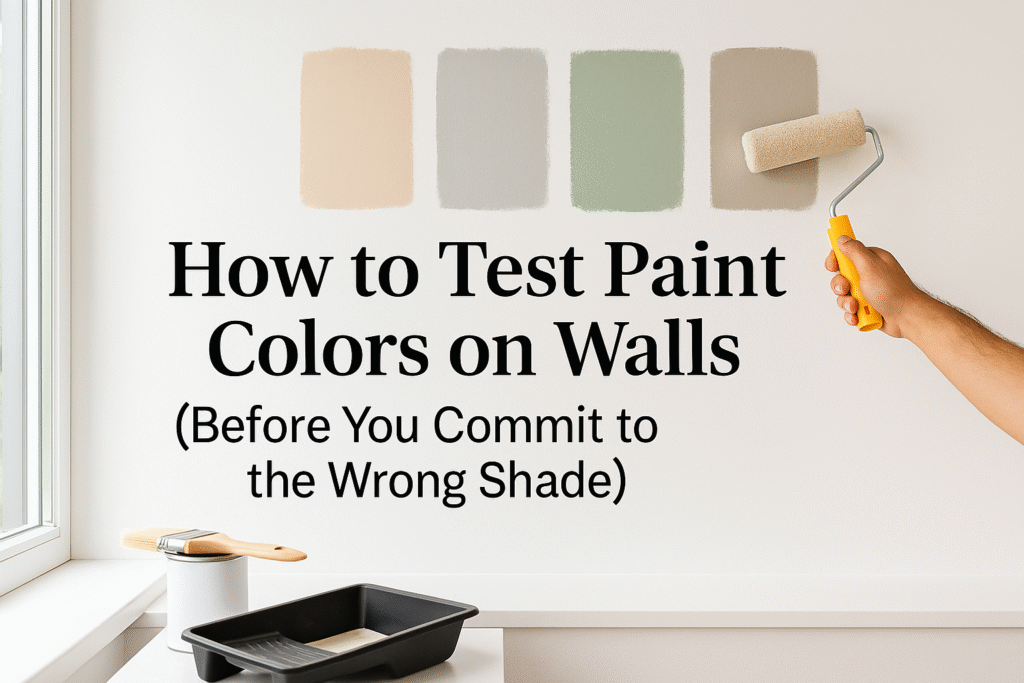Ever painted a room, only to hate the color once it dried? It looked great in the store, but now your walls feel cold, too dark, or just wrong. That sinking feeling? You’re not alone. Choosing the right paint color is one of the hardest parts of decorating. But here’s the good news: You can avoid this mistake by learning exactly how to test paint colors on walls. Yes, testing the right way will save you time, money, and future regret.
How to test paint colors on walls is a simple but essential process before painting any space. In this blog post, you’ll learn the best ways to try out colors, tools to use (like paint sample cards and white foam core board), and how to avoid common mistakes. Let’s get started and make sure your next paint job looks perfect the first time.
Why Testing Paint Colors Matters:
We know the importance of testing paint color, and we know how colors matter a lot.
Lighting Changes Everything:
What appears completely different in daylight, evening light, or artificial light is the same color. The one that appears soft beige in the shop may appear as peach on your bedroom wall. It is why it is important to test in your real space.
Save Money and Time:
Paint does not come cheaply, or so does your time. Testing assists you in not spending any more time repainting or purchasing gallons of a color that you will dislike.
Step-by-Step: How to Test Paint Colors on Walls:
We’re going to explain how to test paint colors on walls, step by step guide.
1. Collect Paint Colour Samples:
When you want to start browsing to check online, visit your local paint store. Most brands provide paint color samples in small pots. These cost much less than full gallons and let you test multiple shades easily. A free paint sample card or painting chip can also help narrow down your choices.
Tip: Stick to 3–5 shades to avoid defeat.
2. Test Colors with Paint and Stick Options:
As we know, mostly brands provide the paint and stick samples. These are peel-and-stick squares of actual dried paint. They’re easy to move around and test on different walls.
They’re great because:,
- No mess
- No need to paint directly on walls
- Can test in different rooms or lighting
They’re also ideal for renters or those not ready to commit to painting yet.
3. Use White Foam Core Board for Easy Testing:
You’d try the white foam core board on the walls instead of the painting directly; you can get it from any craft store. First, try your required color on the board and let it dry, and then move it around the room.
This lets you:
- See how light affects the color
- Compare multiple shades side-by-side
- Avoid making a mess on your wall
It’s reusable and especially useful if you’re testing over white or lightly colored walls.
4. Paint Test Colors on the Wall (The Old-Fashioned Way)
Nevertheless, the most popular one. Provided you are willing to commit fully, your process can be followed to paint test colours on wall surfaces in the following manner:
Tips:
- Draw huge blotches (at least 12×12 inches).
- Test in various walls to observe variations in light.
- Use two coats for true colour
- Let it dry completely. Wet paint looks different.
Don’t exist to paint a patch of one. The more you observe, the better decision you will make.
5. Observe at Different Times of Day:
Under varying lights colours change:
- Morning light: cool and soft
- Afternoon sunshine: hot and bright.
- Evening lighting: can be either yellow or blue.
Test your samples or boards that you are painting during the day. What seemed so good noontime could be boring at 6 p.m.
Bonus Tips for Choosing the Right Color:
- Match with Fixed Elements: Have a look at your flooring, cabinets, tiles, or furniture. The color of your walls must complement what is there. Bring those tones into your trials.
- Test Paints Next to Trim: Your wall paint will be right beside white trim, woodwork, or ceilings. Test around these areas to indicate how it pairs.
- Do Not Try On Too many colors: Have a small number of colors. Excess options = increased indecision.
What Is a Paint Core and Why It Helps:
A paint core is the central pigment and formulation of the colour. Compassionate this helps when comparing similar shades. Some might have a yellow or blue base, which can make two “grays” look totally different. Ask the store staff about the paint core if you’re unsure which direction a color leans.
Mistakes to Avoid When Testing Paint:
1. Painting Over Old Colors Without Primer: In case you are painting a light test color on a dark surface you have to apply the patch of primer. Otherwise, it will be the old shade that will undermine the new shade.
2. Not Letting It Dry Fully: The color of paint gets altered as it dries. Never be in a hurry to make a decision and always be sure you are not wet.
3. Judging Color at One Time of Day: Sample your samples in natural and artificial light. This is to guarantee that your shade is 24/7 working.
From Sample to Gallon: Making the Final Choice
Once you’ve narrowed it down to your winner:
- Note the brand and exact color name
- Take a photo of your favorite swatch in your space
- Buy a gallon (or two) in your preferred finish (matte, eggshell, satin, etc.)
Also, buy all your paint at once to ensure color consistency. Paints can vary slightly between batches.
Tools You’ll Need to Test Paint Like a Pro:
- Paint sample cards
- Small sample pots (test sizes)
- Painting chips for initial selection
- White foam core board
- Paint and stick swatches
- Painter’s tape
- 2″ brush or mini roller
- Notebook to jot down names and impressions
These simple tools make the process faster and cleaner.
When to Use Each Method:
| Testing Method | Best For |
| Painting directly on wall | Most accurate result |
| Paint and stick samples | Quick, no-mess testing |
| White foam core board | Portable and reusable |
| Paint sample cards/chips | Early selection stage |
Still Not Sure? Ask for Expert Help
The paint stores have most of the color consultants in-house. Give a snapshot of your room and samples. They are able to advise you based on professional wisdom and product experience. Online tools and visualizers are also useful, post your photo of the room and test colors online.
Conclusion:
Trying to paint colors is not merely a procedure, it is the most significant one. You are now equipped with information on how to test paint colors on the walls and you can now be confident of finding the shade that makes your space come alive. It is either paint sample cards, white foamcore board, or paint and stick options, but the point is to make the right decision first before purchasing gallons of paint. Be patient, experiment, and make love to your walls, before the first coat is laid on.

